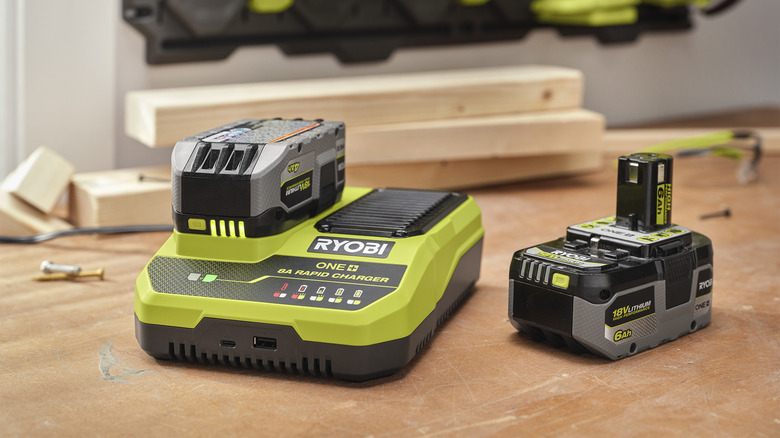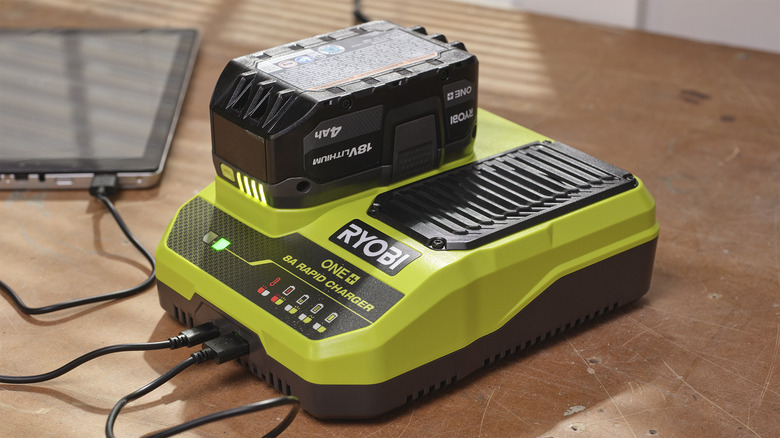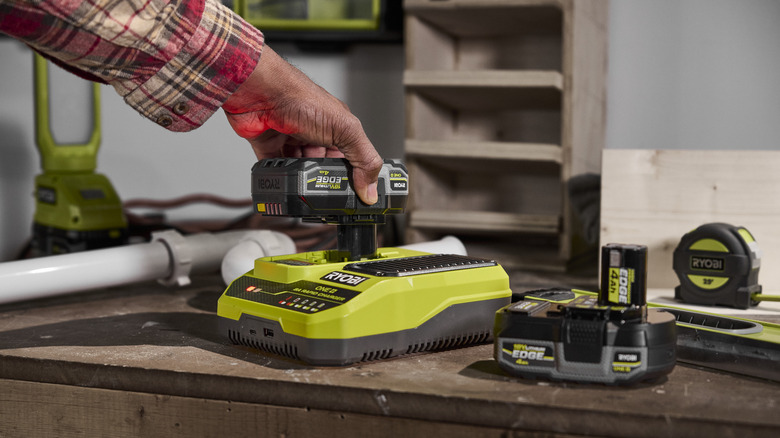Is The Ryobi Rapid Charger Worth It? Here's How Much Faster It Charges
We may receive a commission on purchases made from links.
You can't deny just how much convenience cordless tools have added to your life. Every time you want to drill a hole in your living room, buff your car, or trim your lawn, you no longer need to hunt for a nearby outlet or reach for an extension cord — you just pick up your gear and go. It's incredibly freeing when you don't have to constantly worry about a wire tangling and getting in your way.
One drawback of cordless tools, though, is the charging downtime. You can only use them for a limited time, so picking a reliable charger that fits right into your workflow is important. If you're specifically working with RYOBI ONE+ cordless products, one of the top RYOBI products you need to keep your tools running is a ONE+ battery charger. There are several options you can find on Home Depot, one of which is the Rapid Charger. It's dubbed as RYOBI's fastest charger for the ONE+ system to date, but is it worth buying?
What is the RYOBI Rapid Charger?
The Rapid Charger PCG008 was launched in 2023, along with two new RYOBI 18V ONE+ high-performance batteries: 8Ah and 12Ah. Featuring a charge rate of 8A, it can fully recharge an 8Ah high-performance ONE+ battery in about an hour or a 4Ah high-performance ONE+ battery in 30 minutes or so.
As is standard with other ONE+ battery chargers, the Rapid Charger comes complete with several features, such as LED lights for indicating the charging progress and battery status, a six-foot cable for extended range, and a wall mount for saving space. It's compatible with all of RYOBI's 18V ONE+ lithium-ion batteries, from the standard versions to the high-performance models (the Rapid Charger or any of the RYOBI 18V ONE+ chargers, however, can't charge NiCad batteries).
Besides the ONE+ battery slot, the Rapid Charger is also fitted with one USB-C port and one USB-A port for charging your small electronics. The USB-C port provides a maximum output of 3A, while the USB-A port delivers at most 2.1A.
Ryobi Rapid Charger vs. other Ryobi ONE+ chargers
At an 8A charge rate, the Rapid Charger PCG008 is expected to offer speedy charging times. But how long does it actually take to fully charge RYOBI batteries with this model compared to other chargers in the ONE+ system? Let's break down the charging times of the single-battery chargers in the lineup: The basic ONE+ Charger PCG002 and the Fast Charger PCG004C.
The PCG002 has a charge rate of 2A, and as RYOBI claims, it can juice up a 1.5Ah battery in roughly 45 minutes. Following the battery charging formula (the battery capacity in Ah divided by the charger's charge rate in A), this means the PCG002 can recharge a 2Ah battery in around 60 minutes, a 4Ah in two hours, an 8Ah in four hours, and a 12Ah in six hours. Meanwhile, the Fast Charger PCG004C is designed to output a 4A charge rate twice as fast as the PCG002. That said, you can expect it to fill up a 1.5Ah battery in about 23 minutes, a 2Ah battery in half an hour, a 4Ah battery in one hour, an 8Ah in two hours, and a 12Ah in three hours.
The Rapid Charger PCG008, on the other hand, speeds up the charging process even more — it delivers four times the performance of the PCG002 and twice the speed of the PCG004C. It only takes roughly 12 minutes for this model to recharge a 1.5Ah battery, 15 minutes for a 2Ah, 30 minutes for a 4Ah, 45 minutes for a 6Ah, an hour for an 8Ah, and 90 minutes for a 12Ah.
Is the Rapid Charger worth buying?
While the RYOBI Rapid Charger does power up your batteries in a fraction of the time, there are a few more factors to consider before deciding if it's worth it. For one, think about your typical usage. Are you working on projects daily? Do you use higher-capacity batteries (8Ah or more) all the time? Do you frequently run out of juice in the middle of a job and end up waiting long to get back to it? If you answered yes to all three, then you could benefit from a Rapid Charger.
Since it can quickly recharge your large-capacity batteries in just under two hours, it helps save you time and keeps you productive with fewer workflow interruptions. If, however, you're an occasional DIYer who doesn't drain batteries as often, the Rapid Charger might not be worth the investment. You can get away with using the basic PCG002 charger, as you likely have the flexibility to wait a couple of hours (or maybe even days) before using your battery again.
Beyond your usage pattern, it's worth considering the charger's size, price, and input wattage, too. The Rapid Charger is slightly bigger at 2.59 x 6.4 x 8.22 inches, compared to the PCG002 at only 3 x 3.5 x 6.6 inches and PCG004C at 2.75 x 5.75 x 7 inches. It's also the most expensive of the three. It costs $89 versus $34.97 for the PCG002 and $49.97 for the PCG004. Then, there's the talk of energy consumption. The Rapid Charger draws 230W, considerably more than the PCG002's 60W and PCG004C's 105W. If you have a tight workspace or are watching your budget and power use, you might want to rethink buying a Rapid Charger.



